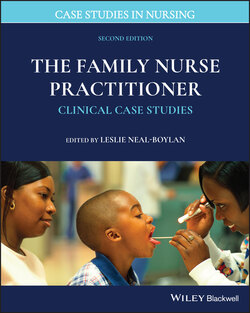Читать книгу The Family Nurse Practitioner - Группа авторов - Страница 33
ОглавлениеCase 4.2 Rash with Fever
By Mikki Meadows‐Oliver, PhD, RN, FAAN
SUBJECTIVE
Seven‐year‐old Aubrey presents to the office with a complaint of a rash for 2 days. She is accompanied by her mother, Jessica. Aubrey has also had a mildly runny nose and cough for 3 days. She has had a low‐grade fever, and her maximum temperature at home was 37.9°C (oral). Aubrey has had no vomiting or diarrhea.
Diet: Normally has a balanced diet with enough dairy, protein, fruits, and vegetables. There has been no change in appetite since her symptoms began.
Elimination: Voiding well with no complaints of dysuria.
Sleep: Sleeps approximately 9 hours at night and has no problems falling asleep or staying asleep.
Past medical history: Aubrey was born via cesarean section at 38 weeks’ gestation for a breech presentation. Since being discharged home at 4 days of age, she has had no hospitalizations. Aubrey had an emergency department visit at 5 years of age for sutures to her head after she fell and struck her head on the corner of a table. She has had no injuries or illnesses since that time
Family history: Aubrey’s mother (34 years old) has a history of migraine headaches. Her father (30 years old) is healthy and has no history of chronic medical conditions. Her 5‐year‐old sibling has Type 1 diabetes. Her maternal grandmother (68 years old) has Type 2 diabetes. Her maternal grandfather (68 years old) has a history of chronic obstructive pulmonary disease (COPD). Aubrey’s paternal grandfather (58 years old) has a history of skin cancer. Her paternal grandmother (53 years old) has hypertension.
Social history: Aubrey currently attends elementary school. She is in the second grade and is doing well, according to her mother. Aubrey lives at home with her parents and her 5‐year‐old sibling. Her father is a graduate student, and her mother is an accountant. The family has a pet rabbit.
Medications: Aubrey is not currently taking any over‐the‐counter, prescription, or herbal medications. Aubrey has no known allergies to food, medications, or the environment. At her last well‐child check, her mother refused the annual flu shot and the second varicella vaccination because Aubrey had a cold. The family did not return to the office to receive these 2 vaccines.
OBJECTIVE
General: Aubrey is alert, active, and cooperative. She appears well hydrated and well nourished.
Vital signs: Weight in the office today is 33 kg. Her temperature is slightly elevated at 37.9° Celsius (oral).
Skin: A predominantly maculopapular rash is noted on her back and chest. Two vesicles are noted on the upper right side of her chest. There is no rash noted elsewhere in her body. There is no cyanosis of her skin, lips, or nails. There is no diaphoresis noted. Skin has elastic recoil.
HEENT: Normocephalic; red reflexes are present bilaterally; and her pupils were equal, round, and reactive to light. There is no ocular discharge noted. Aubrey’s external ear reveals that the pinnae are normal and that there is no tenderness to touch on the external ear. On otoscopic examination, both tympanic membranes are gray, in normal position, with positive light reflexes. Bony landmarks are visible, and there is no fluid noted behind the tympanic membranes. Both nostrils are patent. There is no nasal discharge, and there is no nasal flaring. Aubrey’s mucous membranes are noted to be moist when examining her oropharynx. There is no inflammation of her tonsils, and there are no oral lesions noted.
Neck: Supple and able to move in all directions without resistance. There is no cervical lymphadenopathy noted.
Respiratory: Rate is 20 breaths per minute, and lungs are clear to auscultation in all lobes. There is good air entry, and no retractions or grunting are noted on examination. No deformities of the thoracic cage are noted.
Cardiac: Heart rate is 102 beats per minute with a regular rhythm. There is no murmur noted upon auscultation.
Abdomen: Normoactive bowel sounds are present throughout; soft and nontender. No evidence of hepatosplenomegaly.
Genitourinary: Normal prepubertal female genitalia.
Neuromusculoskeletal: Good tone and full range of motion of all extremities; extremities are warm and well perfused. Capillary refill is less than 2 seconds. Spine is straight.
CRITICAL THINKING
1 Which diagnostic or imaging studies should be considered to assist with or confirm the diagnosis?___Tzanck smear___Viral culture___Direct fluorescent antigen testing___Varicella polymerase chain reaction___Potassium hydroxide (KOH) smear___Throat culture for group A beta‐hemolytic streptococci (GABHS)___Nasal swab for influenza
2 What is the most likely differential diagnosis and why?___Varicella zoster virus (breakthrough)___Herpes zoster___Scarlet fever___Viral exanthem___Lyme disease___Tinea corporis
3 What is the plan of treatment, referral, and follow‐up care?
4 Does this patient’s psychosocial history affect how you might treat this case?
5 What if the patient lived in a rural setting?
6 Are there any demographic characteristics that might affect this case?
